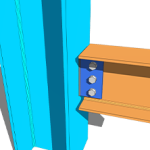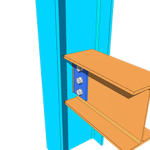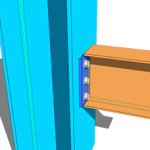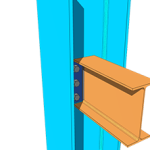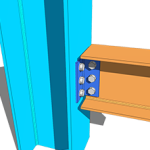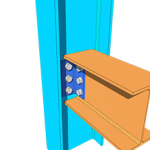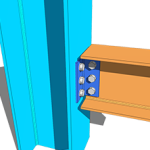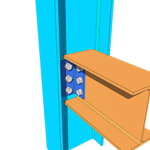De in dit artikel genoemde stalen verbindingen zijn ontworpen in overeenstemming met de Australian Standard 4100:2020, Verbindingshandboek van het Australian Steel Institute 1, en ontwerpgidsen van het Australian Steel Institute 1-5.
Universele balk naar universele kolom
De universele ligger-naar-universele-kolomverbindingen zijn een van de meest voorkomende verbindingstypen die worden gebruikt in staalontwerp. De eerste set AS-verbindingen van SkyCiv zijn allemaal universele balk-naar-universele kolomverbindingen, waarbij de oriëntatie van de kolom kan worden gewijzigd in een flenssteun of lijfsteun. Momenteel, Er kan slechts één verbinding met een knooppunt tegelijk worden ontworpen. Als het gaat om back-to-back-verbindingen, het is raadzaam om conservatieve aannames te doen over het belastingspad.
Afschuifverbindingen
Het meest basale type staalverbinding is een afschuifverbinding. Het is een type verbinding dat alleen te maken heeft met alleen-schuifbelastingen, dat wil zeggen dat er geen andere gelijktijdige belastingen aanwezig zijn. Voor het AS-ontwerp, de volgende afschuifverbindingstypen zijn beschikbaar voor gebruik:
- Webzijplaat – Balk naar Kolom Flens
- Webzijplaat – Web van straal naar kolom
- Flexibele eindplaat – Balk naar Kolom Flens
- Flexibele eindplaat – Web van straal naar kolom
- Enkele hoek – Balk naar Kolom Flens
- Enkele hoek – Web van straal naar kolom
- Dubbele hoek – Balk naar Kolom Flens
- Dubbele hoek – Web van straal naar kolom
- Webzijplaat – Balk naar Kolom Flens
- Webzijplaat – Web van straal naar kolom
- Flexibele eindplaat – Balk naar Kolom Flens
- Flexibele eindplaat – Web van straal naar kolom
- Enkele hoek – Balk naar Kolom Flens
- Enkele hoek – Web van straal naar kolom
- Dubbele hoek – Balk naar Kolom Flens
- Dubbele hoek – Web van straal naar kolom
Het ontwerp van de bovenstaande afschuifverbindingen was voornamelijk gebaseerd op de ASI Design Guides 3, 4, en 5. De referentieformules zijn afkomstig van de AS4100:2020 handmatig, terwijl de rest van de berekeningen of criteria uit het ASI Connection Handbook zijn gehaald 1.
Boutgroepcoëfficiënt
Voor flexibiliteit bij de boutopstelling en boutafstand, SkyCiv heeft de ICOR-methode en inelastische analyse aangepast bij het bepalen van de boutgroepcoëfficiënt C, die vervolgens wordt gebruikt om het afschuifvermogen van de boutgroep en het draagvermogen van de bout te berekenen.
De momentane centrum van rotatiemethode (ICOR) gebruikt iteratie om de IC van de boutgroep te lokaliseren. SkyCiv gebruikt zijn eigen oplosser voor deze iteraties. De locatie van het IC wordt meegenomen in de berekeningen, maar er wordt niet getoond dat de iteraties het rapport beknopter en leesbaarder maken.
De vergelijking die wordt gebruikt om de kracht per bout te berekenen met behulp van de inelastische analyse is gebaseerd op de AISC Eq. (7-1) op pagina's 7-7 van de AISC 15e editie-handleiding. De vergelijking wordt hieronder weergegeven.
\(R = R_{ult}(1-e^{-10\Delta })^{0.55}\)
Omdat de capaciteit van de boutgroep de AISC-methode heeft aangepast, de bepalingen voor het bepalen van de ontwerpboutexcentriciteit van de boutgroep volgen ook de tabel 10-9 van de AISC 15e Ed. Dit is van toepassing op de AS Web Side Plate-verbinding van SkyCiv. Voor enkele hoekverbindingen, zowel de NSL- als de OSL-poten op de enkele hoek zijn ontworpen met excentriciteit van de belasting. Voor dubbele hoekverbindingen, alleen het NSL-been is excentriciteit ontworpen, aangezien het OSL-been symmetrisch gebalanceerd is rond de krachtlijn. Voor flexibele eindplaatverbindingen, er is ook geen excentriciteit op de last, omdat de belasting rechtstreeks op het midden van de boutgroep inwerkt. Al deze boutgroepen zonder excentriciteit nemen dan de boutcoëfficiënt C als het totale aantal bouten in de boutgroep..
Armatuurtypen
Voor hoekverbindingen, het momenteel toegestane bevestigingstype aan de balk en aan de steun zijn geboute typen. Het gelaste type is nog in ontwikkeling en zal binnenkort leverbaar zijn.
Beperkingen detailleren
De detailleringsbeperkingen of de fit-up-controles op de verbindingen zijn ook toegevoegd in de nieuwe release van AS-verbindingsontwerp. De meeste detailleringsbeperkingen zijn gebaseerd op de ASI Design Guides 3-5, terwijl sommige gebaseerd zijn op een intuïtieve technische benadering.
Er wordt ook een geslaagd of mislukt resultaat toegevoegd voor de detailleringscontrole op het tabblad Analyse, zodat dit gemakkelijk door de gebruiker kan worden geïdentificeerd. Het rekenrapport levert tevens een tabel op, hieronder weergegeven, voor de controle op detailleringsbeperkingen. Op deze manier, het item dat moet worden gewijzigd, kan gemakkelijk worden geïdentificeerd.
Meer verbindingstypen
De nieuwe release van AS-verbindingen is nog maar het begin van dit Australian Steel Connection Design. Als u meer verbindingstypen wilt toevoegen, u kunt contact opnemen SkyCiv-ondersteuning.
Wil je deze nieuwe functie proberen? Test het uit via onze Gratis stalen verbindingsontwerpcalculator.

